
Click on the pictures below for a larger view

Passenger cars have various floor plans such
as coach, diner, lounge, parlor, sleeper, private, office and various combinations
(eg sleeper-lounge). In addition there are other passenger train
cars that carry no passengers. They are generally known as
head end cars and are baggage, RPO, dormitory and express cars and combinations
(like baggage dorm). Cutting across all those types are the vertical
variations. There are domes. And there have been dome sleepers (NP, UP,
CB&Q/WP/D&RGW and C&O), dome parlors (CB&Q), dome diners
(only on the UP) and dome lounges and coaches (many roads). There
have been bi-level cars (Amtrak Superliners and Santa Fe Budds) in most
of those floor plans. And finally there is the occasional odd ball:
ARR's former SP "commute" cars are a standard Chicago "gallery" car.
These cars do not have a full upper deck, but rather two balconies running
full length from the center vestibule to the ends. It's just like
putting passengers into the baggage rack of a conventional coach.
Below you will find examples of ARR's passenger cars.
Chugach Explorer
For the 2009 season, the Alaska Railroad had Colorado Railcar Manufacturing construct a bi-level DMU for its Chugach whistle stop project.
See also placard and photo from 2014 open house
GoldStar Service
For the 2005 season, the Alaska Railroad had Colorado Railcar Manufacturing construct two new double-deck luxury dome cars for its exclusive GoldStar Service. Also, check out Jody Moore's information on 651 and 652. And here is a photo of the delivery of numbers 655 and 656 on MRL north of Paradise, MT, 10/23/08.
See also placard
from 2014 open house
The Grandview
In 1999 the Alaska Railroad purchased former Florida Fun Train passenger cars
to create The Grandview.
Coaches: By far the most numerous, these are just what they sound like - a passenger car with lots of seats, just like coach class on an airplane. Coaches often saw many years of service and more than one rebuild during their lifetime. Coaches tend to have a fairly symmetrical row of windows running most of the length of the car on both sides, with smaller windows at the end where the restrooms were located. The ARR has coaches made by Pullman Standard and American Car an Foundry.
Pullman Standard
 |
 |
|
| Coaches 200-204 were manufactured by Pullman Standard in 1950 and rebuilt in 1982. They have a 60 seat capacity. | ||
Enprotech Corp Cars
The ARR's newest coaches were purchased new from Enprotech Corporation.
These passenger coaches are standard size, single-level cars designed for
easy maintenance. They measure 85 feet long, 13 feet 10 inches high and
10 feet wide. Each weighs 126,000 lbs. They are numbered 205 through 210.
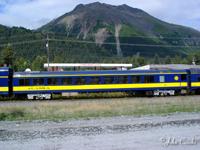 |
 |
| Number 207 is one of the most recent acquisitions from Enprotech Corp. | Each coach seats 78 and is equipped with two toilet rooms. |
Thanks to the Alaska Railroad for providing information on the Enprotech Corp. cars.
See also
High Level (Bi-Level): Bi-levels differ from dome sin that they are usually meant to be operated as a set, and they include coaches, lounges, sleepers, and diners. The first true high level cars were built for the Santa Fe El Capitan in the 1950's. The entire car was raised including the diaphragms and vestibules, with the doors being in the middle of the sides. Amtrak today operates a large number of Superliner high-levels built during the 1970's, as well as some of the original Santa Fe El Capitan cars.
The ARR purchased six Southern Pacific bi-level commuters.
These cars have been used for many years, first for the Whittier cruise
trains and now for the Whittier shuttle. Only three remain and have
been repainted to the new passenger scheme. The rest of the cars
were sold and some were used to build the Princess
tour domes.
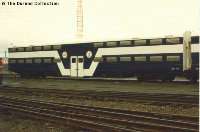 |
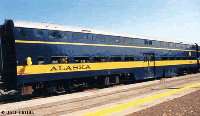 |
| This is the commuter car in Anchorage still in the paint applied by Tillimook Car. | The same commuter car repainted in the ARR paint scheme. |
Thanks to Casey Durand for providing information on the Ex-Southern Pacific Cars.
Head End: These cars are so-called because they typically ran
at the front end of the train behind the locomotive. These cars include
baggage cars, express cars, railway post office cars (mail cars), and crew
or dormitory cars. These cars were mostly railroad-owned and often shop-built,
therefore there are very few truly "generic" head-end cars that would be
correct for more than one railroad. Spotting features: baggage cars generally
are 60' to 70' in length, and have one, two, or three large cargo doors
on each side. RPO cars look like baggage cars with a row of windows
usually offset toward one end. Express cars can be baggage cars, or express
reefers, which were roughly 50' in length for hauling perishables. Dormitory
cars were typically combined with a baggage compartment at one end.
There is also the combine coach, which had a baggage compartment in one
end and coach seats in the other end.
See also placard from 2014 open house
Diners:A typical diner contained a full kitchen and a dining area with tables and chairs. Diners tend to have large "picture windows" in the dining area, small windows in the kitchen area, and usually a side access door on the kitchen side for loading supplies. Diners are almost always asymmetrical and have windows in the passageway opposite the kitchen. Diners can also be spotted by their roof vents over the kitchen.
Now that you are in the dining car section, are you getting hungry? If so, check out the 1950s era menu and then place your order. Or maybe you'll find what you're looking for on this menu.
| Built in 1949 by ACF, this diner has a seating capacity of 48. The ARR had it rebuilt with Head End Power (HEP) in 1982. | 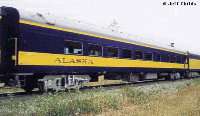 |
See also placard from 2014 open house
Domes: These were typically coaches that had a raised "upstairs"
area with a glass-covered dome. The most common dome configuration has
coach seats at both ends, and a lowered lounge area in the middle, with
the dome section above it.
 |
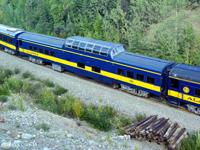 |
|
| Pullman Standard built dome 500 in 1958 while American Car and Foundry built dome 501 in 1954. Both have HEP. | ||
See also placard from 2014 open house
Dome 521, 522, 523 styling elevation and details drawing
Sleepers: For many years, the sleeper was the domain of the Pullman Company, and in fact the name "Pullman" became synonymous with "sleeper". Pullman operated a huge fleet of heavyweight cars in various configurations, sometimes sub-lettered for the railroads that they were assigned to. Pullman cars ran in regularly scheduled trains on every major railroad, but the Pullman porters were employees of the Pullman Co. Pullman continued to operate it's sleeper fleet into the lightweight era, but eventually became a separate entity from the car builder Pullman-Standard. As a result, there were sleepers built by both Budd and ACF that carried the Pullman name during the lightweight era. Pullman eventually sold off it's fleet of cars to the railroads who continued to operate many of them right up to the end.
Since ARR's entire mainline can be transversed in one day, they do not own or have a need for sleepers.
To make for a more meaningful train excursion, the ARR implements a student tour guide program. The provides an incredible benefit for the train's passengers as well as the students.
Notes on Leased Equipment: In May 2005 the ARRC leased six passenger cars to bridge a shortage and provide some spare equipment. The cars were acquired from Montana Rockies Rail Tours (RQAX) and the interiors were typical of Amtrak service from the late 1980's and early 1990's. The roster list is as follows:
Type |
ARR No.
|
MRRT No. |
Comments |
| Dome | 524
|
9407 |
RQAX 9407 ex Amtrak 9477 ex Northern Pacific 550.
Built by Budd in 1954 as a 46 seat revenue dome/coach, with 20 dome seats.
Car was originally used on the North Coast Limited. |
| Dome | 525
|
9410 |
RQAX 9410 ex Amtrak 9471 ex GN 1331. Built by Budd
in 1955 as a 46 seat revenue dome/coach, with 20 dome seats, for the
Great Northern and used on the Empire Builder. |
| Diner | 353
|
3109 |
RQAX 3109 ex Amtrak 8105 ex AT&SF 1560. Built by
Budd in 1948 for the Santa Fe as a Lunch counter lounge car. Converted
by Amtrak to a Buffet Lounge. Car had major mechanical, window and truck
work done in 1999. Converted to a club car with gift shop in 2000. |
| Lounge | 323
|
8750 |
RQAX 8750 ex Amtrak 8529, ex Amtrak 8026, ex Atlanta & West
Point 501. Built by Budd Co. in 1949 for pool service on Southern Railway
trains. Converted to a 36 seat Buffet/Diner by Amtrak late in their Heritage
Program. |
| Coach | 220
|
4001 |
RQAX 4001 ex Amtrak 4415 ex SP2228/2367. By Budd in
1950 for the Southern Pacific as a 44-seat coach for use on the Sunset
Limited. Converted by Amtrak to an ADA car. |
| Coach | 221
|
4013 |
RQAX 4013 ex Amtrak 4418 ex SP2231/2370. By Budd in
1950 for Southern Pacific as a 44 seat revenue car and used on the "Sunset
Limited". Converted by Amtrak to an ADA car. |
On June 6, 2005 one of the cars was found in service on the Glacier Discovery. You will also find initial delivery photos from Steve Noland and Mark Earnest in the archives.
The railroad leased the cars for two seasons knowing they had two new cars on order and a Request For Proposal pending for two more new cars.
Final Note: The American Association
of Private Railroad Car Owners (AAPRCO) is a non-profit body of car
owners, potential owners, and persons and organizations interested in the operation
of private railroad passenger cars. Many AAPRCO members make their cars available
for charter to share the enjoyment of their use. These listings are those of
members who have indicated a willingness to entertain inquiries for the use
of their cars.
And now for the lists:
Footnote: Most westerners do not recognize the difference between a lounge and a parlor. Most observations were lounges or 50% lounge (the rest most often being a sleeper - five or six bedrooms being the most common configuration). Parlor chairs were the Pullman Company's preferred accommodation for day travel. The passenger reserved one just like he would a roomette or any other accommodation, bought a first class ticket from the railroad and paid the Pullman Co. an accommodation charge. The chair was a fixed position swivel chair. (Lounge cars usually had movable chairs.) Many parlor cars also had "day drawing rooms" which normally accommodated up to five passengers in a private compartment (not a Compartment, which was a standard Pullman accommodation occupying the same amount of space as a pair of Sections) These cars were very common in the East. In the post WWII mid-West the IC and Wabash ran them between St. Louis and Carbondale (to connect with north-south trains) and Detroit respectively. The NYC (Michigan Central) , C&O (Pere Marquette), GM&O, Grand Trunk, CB&Q and C&NW used them out of Chicago.
Thanks to Josh Coran, ARR's Chief Mechanical Engineer for supplying all information shown in red

Did you know they use locomotives as passenger cars in Bangladesh? ;-)
Page created 5/31/99 and last updated 1/20/25